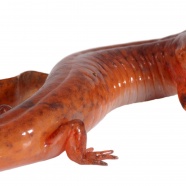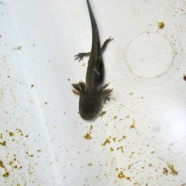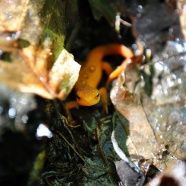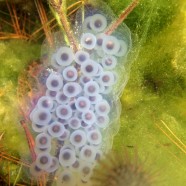Spring Salamander
Hey look – a hot-dog with eyes! Wait, that’s a Spring Salamander (Gyrinophilus porphyriticus)! This large, lung-less salamander is a common resident in the many springs and streams that run through our local forests. It’s stature and bright coloration make it stand out, but also serve as protection from predators. Spring salamanders can grow to over eight inches in length and produce noxious skin secretions while using their color to mimic even more toxic species. It isn’t a salamander any predator would want to mess with, and it probably wouldn’t taste anything...
Read MoreWinter’s Not Over Yet
The fresh blanket of snow across the Western New York landscape is a good reminder that winter isn’t over just yet. However, some of our resident amphibians have been receiving crossed signals due to recent increases in daylight hours and above average temperatures; we have actually gotten reports of salamanders and frogs moving to nearby ponds and vernal pools to lay their eggs. With this weekend’s dropping temperatures, local pools have started to ice over indicating freezing temperatures near the surface. The eggs of some amphibian species are able to cope with fluctuating spring...
Read MoreDragons of the Northeastern Forest?
Do you still consider yourself to be a kid at heart? I definitely have my own “kid” moments when I’m out in the field flipping logs or dip netting pools to see what may be living beneath the surface of the forest floor or a body of water. One species in particular that I love to find in our northeastern forests is the spotted salamander (Ambystoma maculatum). Known for their large black bodies spotted with bright yellow dots, this charismatic species is hard to miss when out in the open. However, they are typically only seen out and about once a year; during their spring...
Read MoreNot All Salamanders Are Newts…
If you’re an amphibian enthusiast, you’ve probably heard this phrase at some point: “All newts are salamanders but not all salamanders are newts.” Does trying to make sense of this cause smoke to come out of your ears? You’re not alone. To shed some light on this conundrum, let’s first consider a bit of taxonomy. Within the Class Amphibia there are three Orders: Caudata, Anura, and Gymnophiona. Caudata refers to the salamanders; species that retain their tails as adults and have four legs. These differ from the Anurans (frogs) which lose their tails as...
Read MoreDo you know your amphibian egg masses?
Despite the snow, the internal clocks of many amphibians are already set to spring. As a result, a number of them have already journeyed from the safety of their winter refuges to nearby pools and ponds to breed and deposit their eggs. This past Friday, prior to the weekend storm, I spent time exploring some local water bodies and found a plethora of these kinds of eggs. Any idea of what these little eggs will eventually turn into? I’ll give you a hint, the bottom picture shows both eggs and spermatophores. If you guessed Spotted Salamander (Ambystoma maculatum), you would be correct!...
Read More








